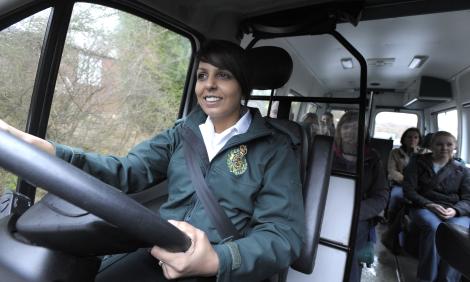Support services
Support services staff carry out a range of tasks in different parts of the NHS. Some keep people or equipment safe, while others transport patients and equipment around hospitals and other NHS sites.

Safe places
Patients, staff and visitors need to be kept safe while they are in hospital or using other NHS sites. Buildings need to be safe to use, with suitable fire exits. Everyone who works in or visits an NHS site needs to know how to keep themselves and others safe. Roles include:
Moving around the site
Hospitals are big places, with long corridors, different wings and, often, separate buildings. Patients may need moving to different parts of the hospital or to and from a hospital or clinic. Equipment needs moving, too, from the stores to the wards, for example. Specialist equipment for conferences and meetings needs setting up. Your role could be:
Safe equipment
When patients are being treated in hospital, it is vitally important that places and equipment are kept scrupulously clean. Everyone in the NHS works very hard to prevent the spread of infection and theatre support and sterile services staff are particularly focused on this.
Support staff need a range of skills and they enter the NHS in different ways. Fire safety officers or audio-visual technicians usually enter with experience (and sometimes qualifications) from elsewhere. Others may start in another NHS role. For example health and safety officers may start in an administrative role or theatre support workers may start as healthcare assistants.
There are support roles, for example porter or security officer, that need few or no qualifications, besides good literacy and numeracy. However, everyone working in support service roles need to have good customer service skills. Your ‘customers’ may be other NHS staff in some cases, but you still need the skills to deal with them courteously, and sometimes in stressful situations.
If you want to progress in the NHS, support services roles all offer the chance to take further qualifications and be promoted to team leader or manager.
-
Health and safety officers make sure that patients, staff and visitors are safe whenever they are in or around an NHS site. They draw up plans and train staff to work safely. Plans cover infection control, safeguarding vulnerable patients, manual handling and food hygiene. When an incident or accident happens, the health and safety officer looks into it.
Fire safety officers make sure all buildings have escape routes and that the risk of fire is kept to a minimum. They organise regular fire drills and train staff in how to deal with patients in case of a fire.
Security staff are at the entrances of NHS hospitals and offices to make sure that people can only enter if they have reason to do so. Security staff deal with any violent or abusive behaviour. They also patrol buildings at night and monitor CCTV.
-
Porters move patients around hospitals, usually in a wheelchair or on a trolley. So porters needs to be fit so they can walk, push and lift. They need to be friendly and calm, too, so they can reassure patients. Porters also move equipment such as stores, gas cylinders, post or linens.
Stores and distribution staff move equipment around and between NHS sites. They might use a van, forklift or trolley. They make sure stocks are delivered where and when they are needed. Stores staff also make sure that stocks are used in the correct order.
Audio visual (AV) staff prepare rooms and equipment for meetings and training courses. Depending on what is needed, they may set up video-conferencing, sound, lighting or recording equipment. They may also operate the equipment during the meeting.
Drivers could use a car or a patient transport ambulance to move patients to and from hospitals or clinics. Other drivers use a van to move equipment between or around NHS sites. Minibus drivers may move staff between sites. Some NHS drivers are volunteers taking patients for hospital appointments.
-
Some NHS equipment is designed to be reused. Decontamination services staff put equipment through decontamination and sterilisation processes to make sure it is safe to use on another patient. Staff have to be very careful to follow procedures and use the equipment correctly to avoid cross-contamination.




